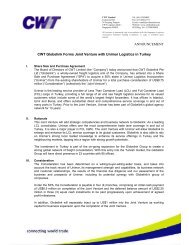notes to the financial statements - Investor Relations
notes to the financial statements - Investor Relations
notes to the financial statements - Investor Relations
You also want an ePaper? Increase the reach of your titles
YUMPU automatically turns print PDFs into web optimized ePapers that Google loves.
CWT Limited<br />
72<br />
NOTES TO THE FINANCIAL STATEMENTS<br />
YEAR ENDED 31 DECEMBER 2011<br />
3 SIGNIFICANT ACCOUNTING POLICIES (CONT’D)<br />
3.13 Revenue recognition (cont’d)<br />
Contract revenue<br />
When <strong>the</strong> outcome of <strong>the</strong> service contract can be estimated reliably, contract revenue and costs are recognised as income<br />
and expense using <strong>the</strong> percentage of completion method, measured by reference <strong>to</strong> <strong>the</strong> contract activity. When it is probable<br />
that <strong>to</strong>tal contract costs will exceed <strong>to</strong>tal contract revenue, <strong>the</strong> expected loss is recognised as an expense immediately.<br />
When <strong>the</strong> outcome of a contract cannot be estimated reliably, contract costs are recognised as an expense in <strong>the</strong> period<br />
in which <strong>the</strong>y are incurred and revenue is recognised only <strong>to</strong> <strong>the</strong> extent of contract costs incurred that can probably be<br />
recovered.<br />
Construction contracts<br />
As soon as <strong>the</strong> outcome of a construction contract can be estimated reliably, contract revenue and expenses are recognised<br />
in <strong>the</strong> income statement in proportion <strong>to</strong> <strong>the</strong> stage of completion of <strong>the</strong> contract. The percentage of completion is measured<br />
by reference <strong>to</strong> <strong>the</strong> percentage of costs incurred <strong>to</strong> date <strong>to</strong> <strong>the</strong> estimated <strong>to</strong>tal contract costs. Contract revenue includes <strong>the</strong><br />
initial amount agreed in <strong>the</strong> contract plus any variations in contract work, claims and incentive payments <strong>to</strong> <strong>the</strong> extent that it<br />
is probable that <strong>the</strong>y will result in revenue and can be measured reliably.<br />
The stage of completion is assessed by reference <strong>to</strong> surveys of work performed. When <strong>the</strong> outcome of a construction<br />
contract cannot be estimated reliably, contract revenue is recognised only <strong>to</strong> <strong>the</strong> extent of contract costs incurred that are<br />
likely <strong>to</strong> be recoverable. An expected loss on a contract is recognised immediately in <strong>the</strong> income statement.<br />
3.14 Employee benefits<br />
Defined contribution plans<br />
Obligations for contributions <strong>to</strong> defined contribution pension plans are recognised as an expense in profit or loss in <strong>the</strong> period<br />
in which <strong>the</strong> employees render <strong>the</strong>ir services.<br />
Short-term employee benefits<br />
All short-term employee benefits, including accumulated compensated absences, are recognised in profit or loss in <strong>the</strong><br />
period in which <strong>the</strong> employees render <strong>the</strong>ir services.<br />
Pension obligations<br />
The Group operates defined benefit pension schemes. The schemes are generally funded through payments from employees<br />
and from <strong>the</strong> relevant Group companies. The assets of <strong>the</strong> plan are held in separately administered funds. The Group’s<br />
defined benefit plans define an amount of pension benefit that an employee will receive on retirement, dependent on one or<br />
more fac<strong>to</strong>rs such as age, years of service and compensation. The Group has no legal or constructive obligations <strong>to</strong> pay<br />
fur<strong>the</strong>r contributions if <strong>the</strong> fund does not hold sufficient assets <strong>to</strong> pay all employees <strong>the</strong> benefits relating <strong>to</strong> employee service<br />
in <strong>the</strong> current and prior periods.<br />
The liability recognised in <strong>the</strong> balance sheet in respect of defined benefit pension plans is <strong>the</strong> present value of <strong>the</strong> defined<br />
benefit obligation at <strong>the</strong> balance sheet date less <strong>the</strong> fair value of plan assets, <strong>to</strong>ge<strong>the</strong>r with adjustments for unrecognised<br />
actuarial gains or losses and past service costs. The defined benefit obligation is calculated annually by independent actuaries<br />
using <strong>the</strong> projected unit credit method. The present value of <strong>the</strong> defined benefit obligation is determined by discounting <strong>the</strong><br />
estimated future cash outflows using interest rates of high-quality corporate bonds that are denominated in <strong>the</strong> currency in<br />
which <strong>the</strong> benefits will be paid, and that have terms <strong>to</strong> maturity approximating <strong>to</strong> <strong>the</strong> terms of <strong>the</strong> related pension liability.





